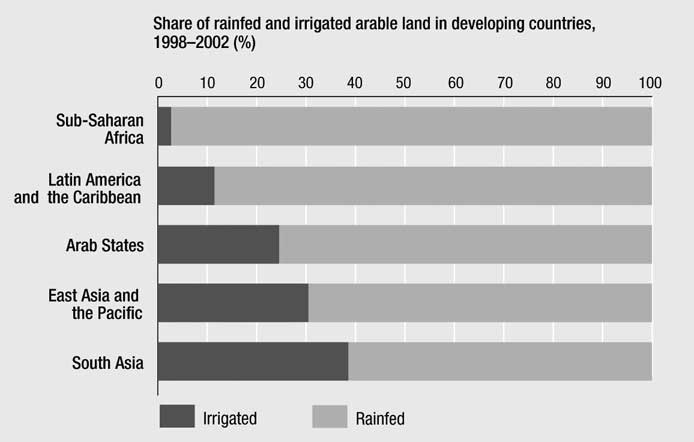also be found in predatory species as a result of biomagnifications, which is the concentration of contaminants in higher levels of the food chain, posing a risk for human health (FAO, 2004b).
Water resources
In the hydrological cycle water resources can be divided into "blue" and "green" water. The main source of water is rain falling on the earth's land surfaces (110,000km3) (CA, 2007). Blue water refers to the water flowing or stored in rivers, lakes, reservoirs, ponds and aquifers (Rockström, 1999). Globally, about 39% of rain (43,500 km3) contributes to blue water sources, important for supporting biodiversity, fisheries and aquatic ecosystems. Blue water withdrawals are about 9% of total blue water sources (3,800 km3), with 70% of withdrawals going to irrigation (2,700 km3). The concept of green water (Falkenmark, 1995) is now used to refer to water that is stored in unsaturated soil and is used as evapotranspiration (Savenije and van der Zaag, 2000). Green water is the water source of rainfed agriculture. Total evapotranspiration by irrigated agriculture is about 2,200 cubic kilometers (2% of rain), of which 650 cubic kilometers are directly from rain (green water) and the remainder from irrigation water (blue water). To date, sub-Saharan Africa has the smallest ration of irrigated to rainfed water and more than half of irrigated land is in Asia (HDR, 2006; see Figure 1-18).
Technological advancements, especially in the construction of dams, have markedly increased the volume and availability of blue water for consumption and irrigation purposes. Similarly, improvements in pumping have motivated farmers to extract more and more groundwater. Moreover, the demand for water has increased at more than double the rate of population increase, leading to serious depletion of surface water resources (Penning De Vries et al., 2003; Smakhtin et al., 2004). Seventy percent of blue water abstraction is for irrigation; given increasing competition from other users water productivity is a priority concern. Furthermore, much of water used in irrigation is lost to lessthan- optimal evaporation, not profiting plant growth.
On the other hand, half of the world's wetlands are estimated to have been lost during the last century, as land was converted to agriculture and urban use, or filled to combat

Figure 1-18. Rainfed and irrigated arable land in developing countries, 1998-2002. Source: HDR, 2006.
diseases, such as malaria. Yet these freshwater wetlands provide a range of services including flood control, storage and purification of water as well as being an important habitat for biodiversity. Worldwide water quality conditions appear to have been degraded in almost all regions with intensive agriculture and other developments (Molden and de Fraiture, 2004). Pollution is a growing problem in most inland water systems around the world while waterborne diseases from fecal contamination of surface waters continue to be a serious problem in developing countries (Revenga et al., 2000).
There is no agriculture without water. Agriculture's sustainability agenda as regards water is twofold: access to clean water for the poor on the one hand, improvements in water productivity and institutional arrangements on the other (CA, 2007).
Half of the world's 854 million malnourished people are small-scale farmers who depend on access to secure water supplies for food production, health, income and employment. Improving their access to clean water potentially has an enormous impact on their livelihoods and productive strategies by reducing poverty and vulnerability (HDR, 2006). With scarcity and competing demands for water increasingly becoming evident, growing more food with less water is a high priority. There is much scope for better water productivity both in low-production rainfed areas and in irrigated systems (CA, 2007). Blue water used in irrigation has a particularly important role, as 40% of global crop production is produced on irrigated soils (WWAP, 2003). In addition, irrigation often depends on dams that impact the environment in various ways, leading to disturbance or destruction of habitats and fisheries (WCD, 2000). To mitigate these impacts, water use efficiency is also paramount. Responses by AKST aiming at improving water use effectiveness include developing micro-irrigation systems (Postel, 1999) and more precise management techniques generally, but also breeding of drought-tolerant crop varieties such as in maize (Edmeades et al., 1999).
Soils
Soil is the source of nutrients required for plant growth and itself the result of organic processes of living organisms. It is therefore the primary environmental stock that supports agriculture. Soil condition varies widely but global estimates suggest that 23% of all used land is degraded to some degree, which is a cause of serious concern (Oldeman, 1994; Wood et al., 2000). The key soil degradation processes include: erosion, salinization and water logging, compaction and hard setting, acidification, loss of soil organic matter, soil nutrient depletion, biological degradation, and soil pollution. Agricultural activities influence all these processes (Scherr, 1999).
In crop cultivation, the resilience of arable soils is an issue of great concern. Different soil types have very different erodibility characteristics, i.e., their ability to resist soil erosion caused by water, wind, or plowing varies a great deal. Some soils will hardly recover once eroded, while others may regenerate within a relatively short time. There are two dimensions to the degradation of soils: first their sensitivity to factors causing degradation, and second their resilience to degradation, which is their ability to recover their original